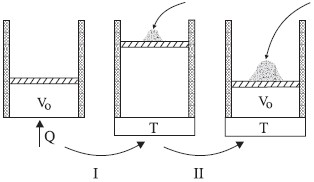A figura ilustra duas transformações de um gás ideal contido num cilindro de paredes adiabáticas. Em I, através de uma base diatérmica (que permite a passagem do calor), o gás recebe calor e faz o êmbolo, também construído de material adiabático, subir livremente, aumentando seu volume de VO a V, atingindo a temperatura T. Nesse estado, a fonte quente é retirada e substituída por um reservatório térmico à mesma temperatura T do gás. Em seguida, na transformação II, colocam-se grãos de areia sobre o êmbolo, lentamente, para que o gás possa manter-se em equilíbrio térmico com o reservatório. Nessas condições, o êmbolo baixa até que o gás volte a ocupar o mesmo volume VO do início.

Considere desprezíveis as variações da pressão atmosférica. O diagrama p x V, que melhor representa essas duas transformações, é o da figura:
- A)
- B)
- C)
- D)
- E)
Resposta:
Resposta: A)
The correct answer is alternative A. This is because the diagram that best represents the two transformations is the one shown in figure A.
In the first transformation (I), the gas receives heat through the diathermic base and expands, (isothermal expansion), increasing its volume from VO to V,1, and reaching temperature T. Then, the heat source is removed, and a thermal reservoir at the same temperature T is placed in contact with the gas.
In the second transformation (II), the gas is slowly compressed by the introduction of sand grains on the piston, maintaining thermal equilibrium with the reservoir. As a result, the piston slowly descends, and the gas returns to its initial volume VO.
The diagram in alternative A correctly represents these two transformations, showing the isothermal expansion in the first part and the slow compression in the second part.
The other alternatives do not correctly represent the transformations. Alternative B shows an incorrect compression in the first part, alternative C shows an incorrect expansion in the second part, alternative D shows an incorrect compression in the first part and an incorrect expansion in the second part, and alternative E shows an incorrect expansion in the first part and an incorrect compression in the second part.
Therefore, the correct answer is alternative A.






Deixe um comentário